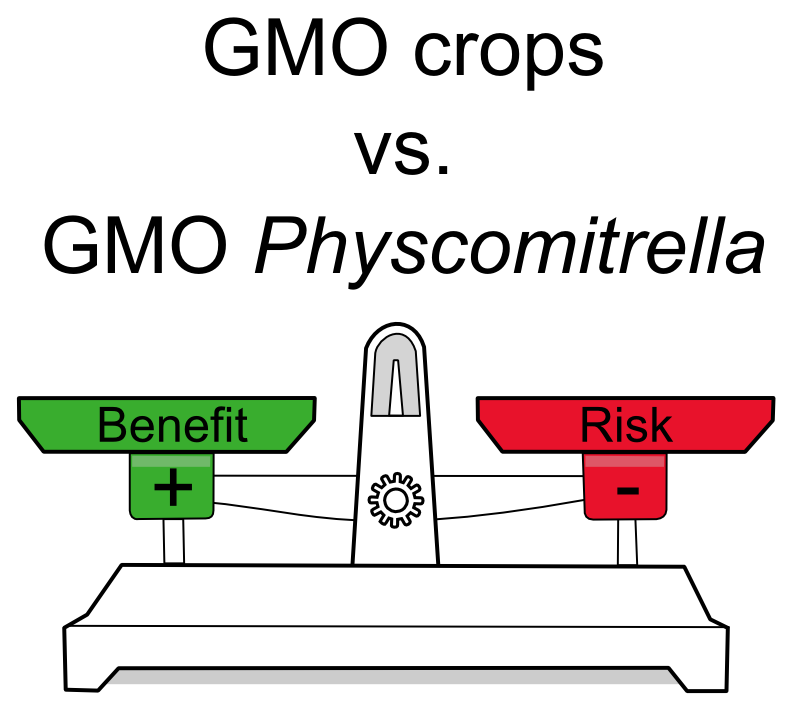Team:TU-Munich/HumanPractice/GMO
From 2013.igem.org
Risk-Benefit Analysis for different genetically modified plants
Example 1: Transgenic Crops
Example 2: Transgenic Moss for Phytoremediation
Assessment and Comparison
Human Practice- equity Golden Rice
Initiation
“What is the context between the three images in figure 1? “ Night blindness is a result of a so called vitamin-A- deficiency (VAD) .Directly in developing countries occur high rates of infection diseases and malnutrition which leads to low immunity. This effects night blindness which can cause complete blindness within few days . The golden rice project is a method of biofortification to combat the VAD with the aid of genetic engineering. The cleaning of the wastewater via the genetic engineered moss Physcomitrella patens in our project leads and aims also to improve the conditions directly in developing countries via genetic engineering.
The Golden Rice Project-humanitarian help with genetic engineering
“I was hungry and you didn’t feed me.” Matt. 25,42 “Let food be your medicine and medicine your food.” Hippocrates 460 BC "This rice could save a million kids a year" Time Magazine, 2000
Historical developing steps of the Golden Rice Project- from idea to reality
“Would it be possible to engineer the biochemical pathway of provitamin A into the rice endosperm to make the rice grain produce enough provitamin to reduce VAD of rice-dependent societies?”
To solve this question was the goal of the both inventors of the Golden Rice Technology: Prof. Ingo Potrykus (emeritus professor; ETH Zurich) and Prof. Peter Beyer (University of Freiburg; department Cell Biology). According to the World Health Organization (WHO) about 2, 3 million children die by reason of VAD and still 250000-500000 children per day go blind mainly in developing countries like Africa and Southeast Asia (see figure 2). To reduce the high rate of vitamin-A-deficiency and malnutrition Prof. Potrykus had the vision to improve the content of micronutrients in food crops. With the aid of the knowledge of the regulation of the terpenoid biosynthetic pathway in the model plant daffodil (Narcissus pseudonarcissus) from Prof. Beyer the plan of Prof. Potrykus completed. The following table (see table 1) should give you a short overview about the fundamental historical developing steps concerning the realization of the project idea. The role of the Chairman of the Humanitarian Board takes Potrykus. In addition to the progenitors and the financial support from the private sector many authorities and members of the Humanitarian Board lead to the benefit of this project in humanitarian genetic engineered help directly in developing countries (see figure 11). The Golden Rice Network is a community work with a strong trust and delivery which involves researchers, breeders, extensionists, and the small farmers. In general all technologies are patented. In total just 12 of the 70 patents were important for the developing countries which were found out by the help of the company Syngenta (before: AstraZeneca). The last has all worldwide commercial right through the treaty, in turn national and international research institutes was assured non-commercial use.So it was necessary to get just 12 licenses for the humanitarian project. It was contractually agreed that the GM-rice just used humanitarian not commercial i.e. the famers get and dispose the rice free and the industry had to abdicate money-disempowerment of license-frees. The GM-rice doesn’t need any herbicides and is expensive like non GM-rice. Also the farmers whose annual income is under $ 10,000 should use the GM rice without licensing costs.
Golden Rice – an impact of human health
“Why choose Beyer and Potrykus rice as the food crop for the genetically modification?”
Refer to table 1 Potrykus addresses with the difficult transformation and regeneration of monocots. The monocot rice is one of the basic staple food crops for half the humanity ( see figure 3) and a major energy source, representing the major carbohydrate and even protein source in SE Asia and Africa. The both inventors developed their project in South and Southeast Asia where 90 % (3 billion people) is grown and consumed rice. Concerning to figure 4 in some places more than half a kilo rice eats a person daily thus the energy intake per day comes from this food crop. Due to the brilliant source of calories the micronutrient content is very low. Another advantage is that the rice doesn’t contain provitamin A (more or less deficient of Vitamin A) which is necessary for humans to create vitamin A. So the lack of rice as a food can lead to VAD mostly affecting children and pregnant women. Rice includes high amount of substance which are needed basically (e.g. polished rice includes 20% of irons, folate, tiny amounts and zinc as the daily requirement).
The science of Golden Rice
Legal regulations on the release of GMO plants
Introduction
Legal regulations in the European Union
Legal Regulation World Wide
Actual Situation in Germany
References:
http://www.ncbi.nlm.nih.gov/pubmed/6327079 Edens et al., 1984
- http://www.ncbi.nlm.nih.gov/pubmed/6327079 Edens et al., 1984 Edens, L., Bom, I., Ledeboer, A. M., Maat, J., Toonen, M. Y., Visser, C., and Verrips, C. T. (1984). Synthesis and processing of the plant protein thaumatin in yeast. Cell, 37(2):629–33.
 "
"




AutoAnnotator:
Follow us:
Address:
iGEM Team TU-Munich
Emil-Erlenmeyer-Forum 5
85354 Freising, Germany
Email: igem@wzw.tum.de
Phone: +49 8161 71-4351